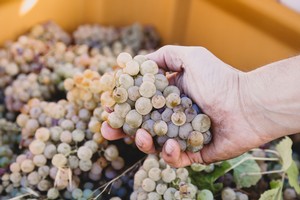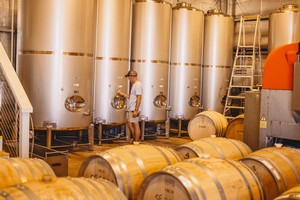The Evolution of Stormflower Chardonnay
Followers of our Chardonnay will have noticed subtle changes in its style over the past few years as we continue our efforts to get the best out of our vineyard and fruit. With the 2022 Chardonnay now starting to mature and the 2023 Chardonnay about to be bottled, we think it is timely to share some of reasons behind this evolution.
 While the Stormflower vineyard is in a beautiful location, it is a rugged and exposed spot to grow wine grapes. The slight northern aspect makes the vineyard hot through the fruit ripening stage, and the elevation of the vineyard and situation between coastal ridges brings onshore winds in at great force to an ancient gravel mound on which our Chardonnay is planted. The Chardonnay block is the most exposed to spring storms, and we often have flowering and fruit set impacted by strong winds and hail. We have been working hard to make the vineyard, and in particular the Chardonnay block, more resilient to extreme weather and disease by focusing on the health of the soil and consequently the vines. We began our organic journey more than 10 years ago and over this time the use of humates, fish emulsion, seaweed products and molasses has improved the native soil microbiology and contributed to soil health and the growing of better cover crops which protect the surface of the soil. To complement these simple organic practices, we have more recently focused on basic management of soil pH and nutrition, particularly organic phosphates, which has created a snowballing effect of good health in the vineyard.
While the Stormflower vineyard is in a beautiful location, it is a rugged and exposed spot to grow wine grapes. The slight northern aspect makes the vineyard hot through the fruit ripening stage, and the elevation of the vineyard and situation between coastal ridges brings onshore winds in at great force to an ancient gravel mound on which our Chardonnay is planted. The Chardonnay block is the most exposed to spring storms, and we often have flowering and fruit set impacted by strong winds and hail. We have been working hard to make the vineyard, and in particular the Chardonnay block, more resilient to extreme weather and disease by focusing on the health of the soil and consequently the vines. We began our organic journey more than 10 years ago and over this time the use of humates, fish emulsion, seaweed products and molasses has improved the native soil microbiology and contributed to soil health and the growing of better cover crops which protect the surface of the soil. To complement these simple organic practices, we have more recently focused on basic management of soil pH and nutrition, particularly organic phosphates, which has created a snowballing effect of good health in the vineyard.
As the grapes reach the winery, we can see the benefits of a vineyard that is more tolerant to stress as the fermenting process is easier and more complete. The level of nitrogen in the vineyard is important for the fermentation process. Lower levels of nitrogen can result in a fermentation that is slower and leaves higher residual sugar in the wine. We don’t use nitrogen fertilisers so we rely on a healthy soil microbiome to produce nitrogen for the vines, and as our soil and vine health has improved so has the available nitrogen, which allows the wine to ferment to dryness more easily. Our earlier Chardonnay vintages tended to have higher residual sugars of between 2 and 3 grams/litre, which gave an immediate richness to the wine and allowed for earlier release. Our more recent vintages are less than 1 gram/litre, resulting in more balanced wines where the natural acidity is more forward and the flavour more subtle as young wines. While our earlier vintages are still drinking well after 10 years, our current vintages are likely to age better for longer.

The commissioning of our own onsite winery in 2020 is also an important factor, and means that the transfer of fruit from vineyard to winery now takes minutes rather than hours, so the fruit arrives in better condition. Since 2022 we have been syphoning the barrels to tank with the use of gravity in preparation for bottling. This gentle handling of the wine is also making a difference in its quality. We are also subtly adjusting our oak selection. Our current barrels are finer grained which pulls the wine tightly together when it is young, makes the finish longer and creates flavours of mineral or slate. This complements the style of our regular oak selection which shows the wine as broad and complex.
Many small incremental changes over a number of years are now starting to show in the wines that we are presenting to our customers. Similarly subtle changes are occurring with all our wines, and we hope that you like the results. From the 2023 vintage we will be trying to hold back Chardonnay vintages for longer before release to give them the opportunity to mature a little in the bottle and ensure customers continue to have opportunity to experience the full expression of the wine on release.